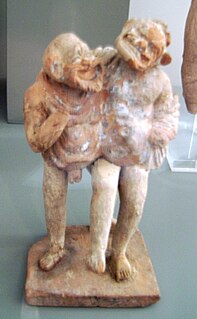 W
WFabula palliata is a genre of Roman drama that consists largely of Romanized versions of Greek plays. Palliata comes from pallium, the Latin word for a Greek-style cloak. It is possible that the term fabula palliata indicates that the actors who performed wore such cloaks. Another possibility is that the fabula itself is metaphorically "cloaked" in a Greek style. As in all Roman drama, the actors wore masks that easily identified which of the stock characters they represented.
 W
WThe theatre area of Pompeii is located in the southwest region of the city. There are three main buildings that make up this area: the Large Theatre, the Odeon, and the Quadriporticum. These served as an entertainment and meeting centre of the city. Pompeii had two stone theatres of its own nearly two decades before the first permanent stone theatre was erected in Rome in the 50s BC.
 W
WThe architectural form of theatre in Rome has been linked to later, more well-known examples from the 1st century BC to the 3rd Century AD. The Theatre of ancient Rome referred to as a period of time in which theatrical practice and performance took place in Rome has been linked back even further to the 4th century BC, following the state’s transition from monarchy to republic. Theatre during this era is generally separated into genres of tragedy and comedy, which are represented by a particular style of architecture and stage play, and conveyed to an audience purely as a form of entertainment and control. When it came to the audience, Romans favored entertainment and performance over tragedy and drama, displaying a more modern form of theatre that is still used in contemporary times. 'Spectacle' became an essential part of an everyday Romans expectations when it came to Theatre. Some works by Plautus, Terence, and Seneca the Younger that survive to this day, highlight the different aspects of Roman society and culture at the time, including advancements in Roman literature and theatre. Theatre during this period of time would come to represent an important aspect of Roman society during the republican and imperial periods of Rome.
 W
WAnkara Roman Theater is the Ancient Roman Theater located between Hisar Street and Pınar Street in Ulus district of Altındağ district in Ankara, the capital city of Turkey. Although the exact date of construction is not known, it is dated to the 2nd century AD.
 W
WThe Archive of Performances of Greek and Roman Drama (APGRD) is a research project based at the University of Oxford, England, founded in 1996 by Edith Hall and Oliver Taplin. The current director is Fiona Macintosh.
 W
WThe Atellan Farce, also known as the Oscan Games, were masked improvised farces in Ancient Rome. The Oscan athletic games were very popular, and usually preceded by longer pantomime plays. The origin of the Atellan Farce is uncertain, but the farces are similar to other forms of ancient theatre such as the South Italian Phlyakes, the plays of Plautus and Terrence, and Roman mime. Most historians believe the name is derived from Atella, an Oscan town in Campania. The farces were written in Oscan and imported to Rome in 391 BC. In later Roman versions, only the ridiculous characters read their lines in Oscan, while the others read in Latin.
 W
WDalheim Ricciacum is the site of a Gallo-Roman vicus at Dalheim in south eastern Grand Duchy of Luxembourg. Founded during the reign of the Emperor Augustus, the site was at a strategic point on the Via Agrippa, the main Roman road from the Mediterranean to the Rhine. The well-preserved theatre dating from the 2nd century AD could accommodate 3,500 people.
 W
WLudi were public games held for the benefit and entertainment of the Roman people . Ludi were held in conjunction with, or sometimes as the major feature of, Roman religious festivals, and were also presented as part of the cult of state.
 W
WThe naumachia in the Ancient Roman world referred to both the staging of naval battles as mass entertainment, and the basin or building in which this took place.
 W
WIn Greek mythology, Silenus was a companion and tutor to the wine god Dionysus. He is typically older than the satyrs of the Dionysian retinue (thiasos), and sometimes considerably older, in which case he may be referred to as a Papposilenus. The plural sileni refers to the mythological figure as a type that is sometimes thought to be differentiated from a satyr by having the attributes of a horse rather than a goat, though usage of the two words is not consistent enough to permit a sharp distinction. The etymology of God Seilenos comes from σείω – shake, move to and fro and ληνός – wine, and meaning "Shattering, drunken god of wine." Undoubtedly, Seilenos presides over other daemones and is related to musical creativity, prophetic ecstasy, drunken joy, drunken dances and gestures.
 W
WThe scaenae frons is the elaborately decorated permanent architectural background of a Roman theatre stage. The form may have been intended to resemble the facades of imperial palaces. It could support a permanent roof or awnings. The Roman scaenae frons was also used both as the backdrop to the stage and behind as the actors' dressing room. Largely through reconstruction or restoration, there are a number of well-preserved examples.